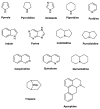Naturally-Occurring Alkaloids of Plant Origin as Potential Antimicrobials against Antibiotic-Resistant Infections
- PMID: 32784887
- PMCID: PMC7466045
- DOI: 10.3390/molecules25163619
Naturally-Occurring Alkaloids of Plant Origin as Potential Antimicrobials against Antibiotic-Resistant Infections
Abstract
Antibiotic resistance is now considered a worldwide problem that puts public health at risk. The onset of bacterial strains resistant to conventional antibiotics and the scarcity of new drugs have prompted scientific research to re-evaluate natural products as molecules with high biological and chemical potential. A class of natural compounds of significant importance is represented by alkaloids derived from higher plants. In this review, we have collected data obtained from various research groups on the antimicrobial activities of these alkaloids against conventional antibiotic-resistant strains. In addition, the structure-function relationship was described and commented on, highlighting the high potential of alkaloids as antimicrobials.
Keywords: alkaloids; antibiotic resistance; antimicrobials; methicillin-resistant Staphylococcus aureus; natural products; plant-derived alkaloids; structure–activity relationship; vancomycin-resistant enterococci.
Conflict of interest statement
The authors declare no conflict of interest.
Figures





References
-
- Cassini A., Hogberg L.D., Plachouras D., Quattrocchi A., Hoxha A., Simonsen G.S., Colomb-Cotinat M., Kretzschmar M.E., Devleesschauwer B., Cecchini M., et al. Attributable deaths and disability-adjusted life-years caused by infections with antibiotic-resistant bacteria in the EU and the European Economic Area in 2015: A population-level modelling analysis. Lancet Infect. Dis. 2019;19:56–66. doi: 10.1016/S1473-3099(18)30605-4. - DOI - PMC - PubMed
Publication types
MeSH terms
Substances
Grants and funding
- ARS01_00432 PROGEMA/Piano Operativo Nazionale (PON)
- PRIN 2017-"Targeting Hedgehog pathway: Virtual screening identification and sustainable synthesis of novel Smo and Gli inhibitors and their pharmacological drug delivery strategies for improved therapeutic effects in tumors/Ministero dell'Istruzione, dell'Università e della Ricerca
- Dipartimenti di Eccellenza- L. 232/2016 and Sapienza University of Rome (Project RM11816436113D8A/Ministero dell'Istruzione, dell'Università e della Ricerca
LinkOut - more resources
Full Text Sources
Medical
Molecular Biology Databases

